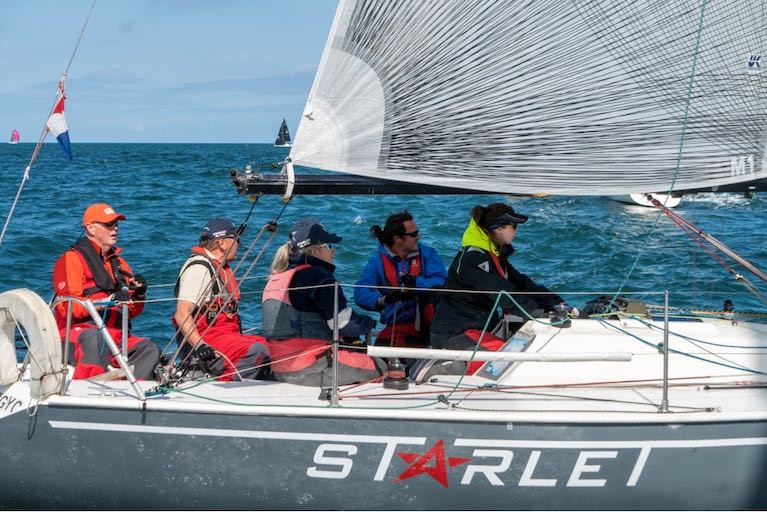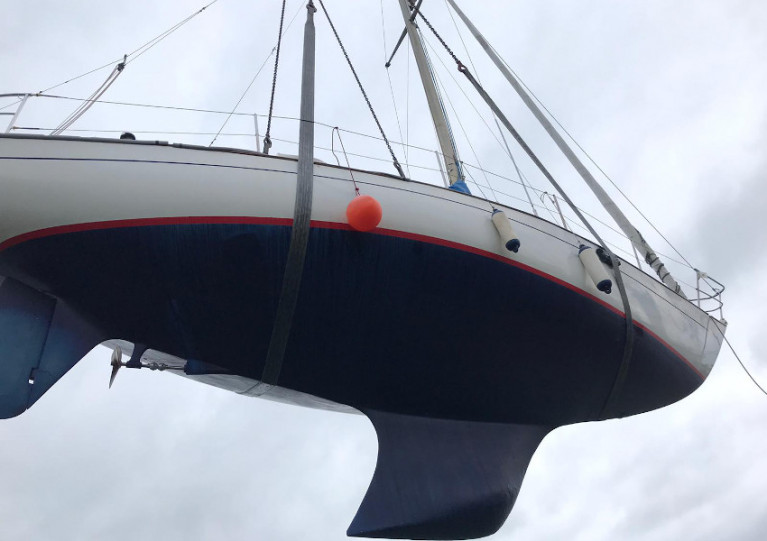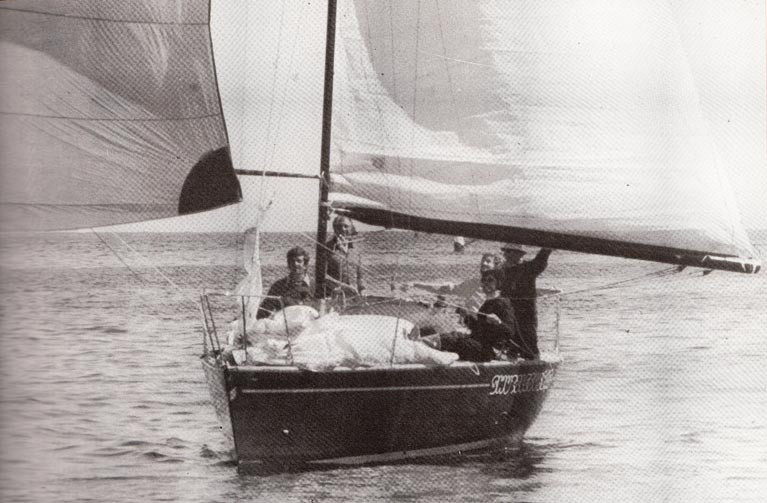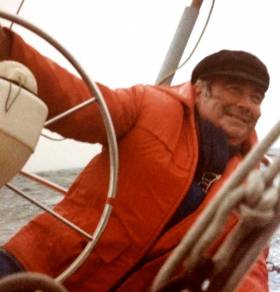Displaying items by tag: Royal St George YC
Royal St George YC’s Denis Power To Contest Sydney-Hobart Race
The 2023 Rolex Sydney-Hobart Race on December 26th is now less than two months away, and with the entry list closed at 120 boats, we’re learning of more direct Irish involvement to add to Cian McCarthy and Sam Hunt of Kinsale and Cinnamon Girl fame campaigning the two-handed division in a Sun Fast 3300 chartered in Sydney from ex-Limerick Lee Condell, while Trevor Smyth of the Clontarf Sailor Smyths will be out again in Mick Martin’s TP 52 Frantic (ex-Patches) to see if they can replicate their winning form in last month’s inaugural 1250-mile Sydney-Auckland Race.
Obviously, a full-on involvement by a complete Irish crew is a huge logistics and local contacts-requiring challenge, exacerbated by the fact that even the most obliging people in the Sydney Harbour marine industry will be caught up in their family’s count-down and celebration for Christmas. But Denis Power of the Royal St George YC – well known for his involvement with the J/97 Windjammer in Cruisers 2 in Dublin Bay – has hit on a really cool way of minimising the hassle.
 Denis Power has hit on a cool way to minimize the hassle of gaining Sydney-Hobart experience
Denis Power has hit on a cool way to minimize the hassle of gaining Sydney-Hobart experience
He has simply bought a berth to Hobart aboard Flying Fish Sailing’s Radford/McIntyre 55 Arctos. This interesting and well-proven racer has something of the Transpac sled about her, but however you see her, she is a very good bet for adding worthwhile Sydney-Hobart participation to your sailing CV.
Flying Fish Sailing have been steadily developing from small beginnings nearly thirty years ago, and these days the organisation’s extensive range of training and sailing at all levels in every setting is a powerful resource both for sailing in Australia, and at an international level.
Carolina Carra of the Royal St George Yacht Club Lying 18th at Euromed Cup
Day one of the Mapfre Euromed Cup in Malta yielded interesting results for the Irish competitors.
In the 138-boat Optimist Fleet, Carolina Carra of the Royal St George Yacht Club managed the best of the Irish boys and girls, earning a very credible 18th place in the third and final race of the day and is lying in 59th place overnight.
In the ILCA 4 fleet, Lucy Ives, sailing under the Carlingford Sailing Club burgee, started the day well with a 7th and a 6th in races 1 and 2 but slipped to 18th in the day's final race, leaving her in 9th overall at this stage.
Close behind her is the Royal St George pair of Emily Conan and Jessica Riordan in 12th and 13th, respectively, with Howth’s Charlie Keating in 14th.
New to the fleet is Ella Fitzgerald of the National Yacht Club, whose best position today was 28th. She will be looking to improve in tomorrow’s slightly lighter forecasted wind.
At the top of the fleet in the ILCA 6 is Malta’s Shaun Aquilina, closely followed by ILCA 4 2022 European Champion Irene De Tomas Perello from Spain. Daniel O’Connor is Ireland’s beast-placed boy in 9th overall. The Royal St George Sailor will look for more results like his third place in today’s final race when racing resumes tomorrow.
Full results here:
Fiachra & Caoilinn Geraghty-McDonnell of Royal St George YC in Dun Laoghaire are Sailors of the Month (Junior) for September
Although it will be Fiachra Geraghty-McDonnell’s name on the main trophy in the Junior Helms Nationals 2022, winning it was a family team effort, as his sister Caoilinn – a proven Optimist star – forsook her own place as of right as a junior helm, and elected to crew for her brother instead.
In a long and demanding series, their underlying quality of performance led to a steadily upward curve of results to make Fiachra the Junior National Champion 2022 at Schull, coming tops against a formidable line-up of established and rising talent from every main sailing centre in the country.
Royal St George YC Sets The Pace In Junior All-Ireland Title
The Royal St George YC in Dun Laoghaire may have been founded way back in 1838, and it makes its headquarters in one of the stately classic buildings which set the traditional style on the harbour waterfront.
But 184 years after its founding to serve the needs of a special very established niche in Irish society where young sailors were seldom seen, let alone heard, it's now in some ways a different place altogether.
This evening, RStGYC is right up to speed on national junior sailing with the win and a four-place dominance in the first six places at the conclusion today (Sunday) of the national All-Ireland Junior Championship in Schull, West Cork.
And it does it with a team list which reads more like the roll call at a Gaeltacht Summer School than resonating with the names of RStGYC sailors of yore.
The preliminary published results give RStGYC's Fiachra Geraghty-McDonnell the win, and though the second place was taken by Ben O'Shaughnessy of the Royal Cork, two more Royal St George junior sailors - Archie Daly and Trevor Bolger - come in at third and fourth with Howth then getting a two-place look-in, with rising Optimist star Harry Dunne placing fifth ahead of Youth Worlds Gold Medallist and defending champion Rocco Wright in sixth.
Junior Champions’ Cup 2022 results
| Boat | Helm | Club | Class | R1 | R2 | R3 | R4 | R5 | R6 | R7 | R8 | M | Tot | Net | Place |
| 3 | Fiachra Geraghty -McDonnell | Royal St. George Yacht Club | ILCA 6 | 1 | 2 | 4 | 4 | 10 | 1 | 1 | 4 | 2 | 29 | 19 | 1 |
| 1 | Ben O’Shaughnessy | Royal Cork Yacht Club | 29er | 6 | 1 | 3 | 1 | 2 | 3 | 2 | 12 | 16 | 46 | 34 | 2 |
| 14 | Archie Daly | Royal St. George Yacht Club | Team Racing | 4 | 3 | 2 | 3 | 4 | 4 | 5 | 9 | 12 | 46 | 37 | 3 |
| 13 (Sail21) | Trevor Bolger | Royal St. George Yacht Club | Team Racing | 3 | 4 | 1 | 2 | 6 | 5 | 3 | 6 | 20 | 50 | 44 | 4 |
| 2 | Harry Dunne | Howth Yacht Club | Optimist | 9 | 9 | 5 | 10 | 3 | 7 | 4 | 2 | 10 | 59 | 49 | 5 |
| 22 | Rocco Wright | Howth Yacht Club | ILCA 6 | 2 | 8 | 7 | 9 | 9 | 9 | 6 | 10 | 4 | 64 | 54 | 6 |
| 15 | Patrick Foley | Royal St. George Yacht Club | RS Feva | 8 | 7 | 12 | 5 | 5 | 6 | 8 | 7 | 8 | 66 | 54 | 7 |
| 20 | Lucia Cullen | Royal St. George Yacht Club | 29er | 15 | 6 | 10 | 6 | 1 | 2 | 12 | 15 | 6 | 73 | 58 | 8 |
| 9 | Adam McGrady | Galway Bay Sailing Club | 420 | 12 | 5 | 8 | 12 | 11 | 8 | 7 | 1 | 14 | 78 | 66 | 9 |
| 12 | Riona McMorrow Moriarty | Tralee Bay SC, RCYC | Topper | 10 | 10 | 9 | 8 | 7 | 10 | 11 | 11 | 18 | 94 | 83 | 10 |
| 5 | Conor Cronin | Malahide Yacht Club | Optimist | 14 | 16 | 5 | 15 | 5 | 11 | 9 | 8 | 83 | 67 | 11 | |
| 4 | Isha Duggan | Royal Cork Yacht Club | Optimist | 7 | 11 | 6 | 13 | 12 | 13 | (UFD) | 5 | 84 | 67 | 12 | |
| 6 | Max Cully | Blessington Sailing Club | Gp14 | 13 | 13 | 13 | 11 | 6 | 15 | 14 | 3 | 88 | 73 | 13 | |
| 10 | Hannah Dadley-Young | Ballyholme Yacht Club | ILCA 4 | 11 | 15 | 15 | 7 | 8 | 14 | 13 | 14 | 97 | 82 | 14 | |
| 11 | Alexander Fought | Blessington Sailing Club | Mirror | 5 | 12 | 14 | 16 | 14 | (UFD) | 15 | 13 | 106 | 89 | 15 | |
| 8 | Georgia Goodbody | Royal Irish Yacht Club | Waszp | 16 | 14 | 16 | 14 | (UFD) | 12 | 10 | 16 | 115 | 98 | 16 |
Boatpersons both Full and Part-Time are required at the Royal St. George Yacht Club in Dun Laoghaire, Co. Dublin.
Positions Available:
Full time and casual hours are subject to the demands of the Sailing Season and full-time year-round.
Who we are:
Located in Dún Laoghaire, the Royal St. George Yacht Club was founded in 1838 and is one of Ireland's premier yacht clubs. With Sailing 7 days a week throughout sailing season and most weekends throughout the winter there are always activities taking place.
Job Description:
The Boatperson, reporting to the Boathouse Supervisor, will work as a member of the Boathouse Team to facilitate the smooth and professional operation of sailing activities and member services. The Boatperson will drive the club launches, cranes and forklift, work on the Deck and Forecourt to assist with the lifting and launching of boats and will help maintain club equipment and carry out maintenance on members' boats as required.
The Ideal Candidate:
Will have prior experience in a boatyard or marine environment. Possess a strong knowledge, understanding and experience of boats, maintenance, and operation. The successful candidate will be responsible, hardworking and able to work on their own initiative or as part of a team.
Strong interpersonal and customer service skills are important as is the ability to work to the demands of a seasonal position in the leisure industry that will involve working outside normal office hours and on holidays and weekends.
Salary/ pay based on candidate's experience.
To apply please email a copy of your C.V. along with a cover letter to [email protected] or post to the Sailing Manager, Royal St. George Yacht Club, Dun Laoghaire, Co. Dublin.
Ronan Adams
Sailing Manager
ROYAL ST. GEORGE YACHT CLUB
Marine Rd, Dun Laoghaire,
Co. Dublin.
Ireland
Eircode A96 AY77
The learned word for the study of flags is "vexillology". Had we been told that it shares its roots with "vexation", it wouldn't have surprised us at all, living as we do just down the road from a region where the interpretation of "flegs'n'omblums" is a deadly serious business.
But in fact, it goes back to the "vexillum", the special distinctive banner-flag carried by the Roman legions, which thereby became a clear symbol to all those peace-loving primitive tribes, getting on with their idyllic back-to-nature lives out in the boondocks, that trouble was on the way.
Since then, we've been right through the mill with the manifestations of vexillating. And certainly, there was a time when having a clear flag-like symbol was very important indeed, in all those ages when mankind was blighted by poor communications, untreatable deafness, and lousy eyesight.
It goes some way to explain why many wind-driven warships of the olden days used to head off for battle flying distinctive ensigns which were often much larger than many of their sails. For it was bad enough having to engage with the enemy, but having your rig shot away by some half-blind crew who were supposed to be on your side could ruin your entire day.
 The Marquis of Conyngham, first Commodore of the Royal St George Yacht Club from 1845-1862.
The Marquis of Conyngham, first Commodore of the Royal St George Yacht Club from 1845-1862.
So it was only natural as the early yacht clubs got going - with all their recreational versions of naval behaviour and style – that flags should immediately be playing an important role, with flag etiquette top of many an inter-club agenda.
That it all could become a pernickety and contentious affair was inevitable, and as vexillology got into its nautical stride during the 19th Century, as sure as God made little apples there was trouble in Ireland. Until the mid-1840s, several of the clubs with a royal warrants were entitled to fly the white ensign of the Royal Navy. But some busybody in the Admiralty decided this wouldn't do, and the word went out to all relevant clubs, except the favoured Royal Yacht Squadron, that the practice was to cease immediately.
Unfortunately, this general order overlooked the fact that the Royal Western of Ireland Yacht Club was still in existence, albeit in a parlous way. The irony of it all was that when the white ensigns were being dished out around 1831, the RWIYC said that they'd actually prefer to have a green version of the white ensign, if that were possible, but were told it most emphatically wasn't.
Yet when their few remaining yachts still flying the white ensign in the 1850s were tracked down, they fought like terriers (admittedly rather aged terriers by then) to retain the privilege. We could continue with this sideline story for ever, but suffice to say that, in the ultimate irony, hidden in a corner of the snooker room of the Royal Ulster YC, there's an ancient green RWIYC ensign on discreet display……
 A unique flag in many ways – the Marquis of Conyngham's well-used 1847 RStGYC ensign is up for auction on April 13th
A unique flag in many ways – the Marquis of Conyngham's well-used 1847 RStGYC ensign is up for auction on April 13th
Meanwhile, a reminder of the vexillologically disputatious days of the 1840s has come to light with collector and auctioneer Niall Mullen flagging – how else? - an online sale in association with Victor Mee on April 13th & 14th, in which one of the more intriguing items will be the personal 1847 ensign of the first Commodore of the Royal St George Yacht Club, the Marquis of Conyngham.
At the time, the club was in the process of settling into being known as the Royal St George's YC – soon to be the plain Royal St George – where previously it had been the Royal Kingstown Yacht Club. But equally, there was some to-ing and fro-ing as to the form its ensign should take under the new Admiralty dispensations.
Thus it's just possible that with his simple red ensign with its symbol-defaced union flag on the top left-hand corner, the often-absent Commodore was showing what he thought the new flag should be like. But back in Kingstown, the Committee had their own ideas, as revealed in the history of the Club published in 1988, which suggests that many members wished to continue with the established flags.
 The historic flags of the Royal St George YC/Royal Kingstown YC, as collated in 1847 and published in the Club History in 1988, its 150th Anniversary. The club's own version of the ensign is markedly different from that flown by their first Commodore, but subsequently the agreed ensign became simpler, defaced by a crown on the red ground in the lower right quarter
The historic flags of the Royal St George YC/Royal Kingstown YC, as collated in 1847 and published in the Club History in 1988, its 150th Anniversary. The club's own version of the ensign is markedly different from that flown by their first Commodore, but subsequently the agreed ensign became simpler, defaced by a crown on the red ground in the lower right quarter
Central to its page displaying the relevant flags is an ensign of red ground with a superimposed white St George's Cross, and the plain union flag top left. Doubtless qualified vexillologists will have their technical terms for every aspect of the design, but all it indicates to us simple souls is that in 1847, the Commodore of the Royal St George YC may have had one notion of what the club ensign should be like, while the Committee perhaps had another.
It's clear evidence of – how shall we say – a difference of opinion which might provide some added value, for although it has come direct from Slane Castle, it is very modestly guided at €1,000 to €2,000. That said, according to one newspaper preview of the sale, the ensign is accompanied by a letter of provenance from the "Royal Marine Museum" in Dun Laoghaire. That sounds like it might be a lot of fun if only such a place existed, but maybe the National Maritime Museum in Dun Laoghaire has clarified the matter.
Be that as it may, another item in the sale might also be of interest. It's a Tibetan kangling, or leg flute. It's so called not because you somehow play it by leg, but because it's made from the thigh bone of a Tibetan mountainy man. As the rest of the mountainy man is no longer attached, it's modestly guided at €400-€600.
Royal St. George Yacht Club Celebrate DBSC Cruiser, One Design & Dinghy Victories
Lindsay Casey's Royal St. George Yacht Club J97 Windjammer that has performed on both inshore and offshore circuits this season was the winner of the best yacht on handicap and has lifted Dublin Bay Sailing Club's premier Waterhouse Shield award.
The overall results were announced recently by DBSC but unfortunately without the usual end of season prizegiving.
In Cruisers Two division, the premier award winner also won both the Lady Shamrock Trophy for Thursdays IRC racing and the Silver Salver for Saturdays IRC competition. On top of these inshore results, the Royal St. George J-boat also competing in some of this season's ISORA coastal races from Dun Laoghaire Harbour. There were other Royal St. George Yacht Club victories in Class Two too. Among them was Dick Lovegrove's Sigma 33 Rupert that won the JB Stephens Trophy for the combined Thursday and Saturday performance.
 Royal St. George J97 Windjammer
Royal St. George J97 Windjammer
In the Cruisers Three division, Kevin Byrne's Starlet (pictured top) was the winner of Tuesday's Thursdays and Saturday's IRC picking up the Whimbrel Rose Bowl, Smalldridge Cup and Jack Kennedy Memorial Cup respectively.
In Cruisers Five, the Gerry Henry Salver for Thursdays ECHO Overall Div A went to Thomas Dunne's Katienua.
In the Mixed Sportsboats, a cut-glass tumbler went to Jonathan Craig for his Tuesday performance in the J80 'George 5'.
Royal St. George One Designs
In the SB20s Michael O'Connor, Davy Taylor and Ed Cook celebrated their double win of The Crichton Cup for Thursday Racing and the
SB Cup for Saturday racing.
Royal St. George Dinghies
In the PY dinghy class, Brendan Foley's RS Aero Minty was the Early Bird Trophy Saturdays overall winner.
In the Lasers, Sanderling Trophy for Saturdays Overall in the Standard division went to Finn Walker.
And in the Radial division, Sean Craig won the Jimmy Mooney Trophy for Tuesday and Saturday racing combined plus a cut-glass tumbler for Tuesday racing overall.
See the full DBSC prizewinners list here.
Royal St George Hails Successful Annual Lift-In
The long-delayed lift-in day at the Royal St George went ahead yesterday (Sunday 7 June) with the club’s typical speed and efficiency.
The Dun Laoghaire club offered a sincere thank-you to all of its staff, volunteers and members who helped make the day happen, all while maintaining the social distance rule where possible.
Vice Commodore Richard O’Connor was moved to write a brief note following the postponed lift-in:
“Today was my personal favourite day in the yearly schedule of the club, lift-in. We had to postpone it from yesterday due to a particularly bad slop with the wind coming from the north.
“A huge word of thanks to David Freeman, Robert Fowler and the other volunteers for all their work but also in particular I want to thank David for his words of praise for the young team that were assembled to make sure all our members boats were lifted in while their owners could remain safe.
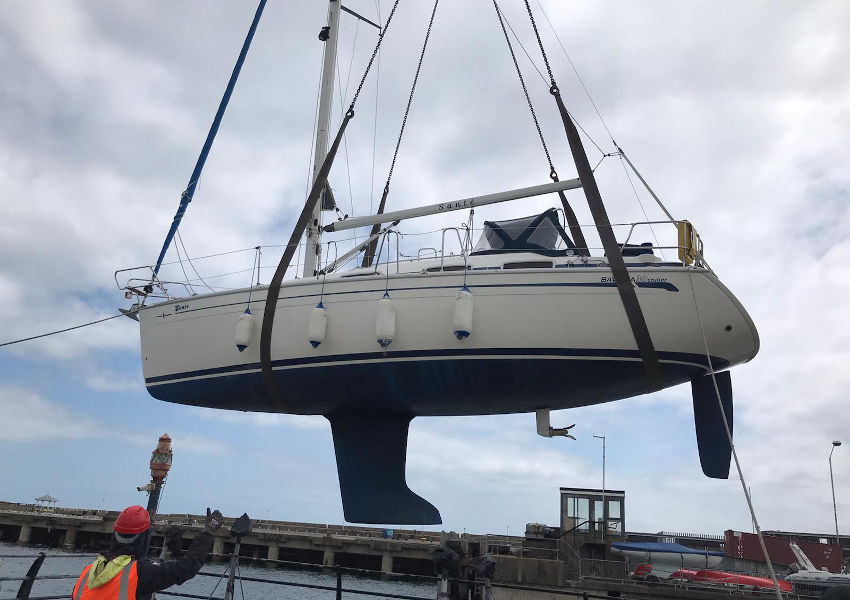
“According to David, the team today ‘was the best team he had ever seen’ and they were incredibly efficient. At 9am this morning, having assembled at 6.15am for briefing, the lift-in was one-and-a-half hours ahead of schedule.
“At approximately 11am, having paused for breakfast (the first catering offering on site since social distancing was implemented, so well done Jamie and team), we stopped lifting in boats and instead did the pontoon as we couldn’t get in touch with the members whose boats were being lifted in fast enough.
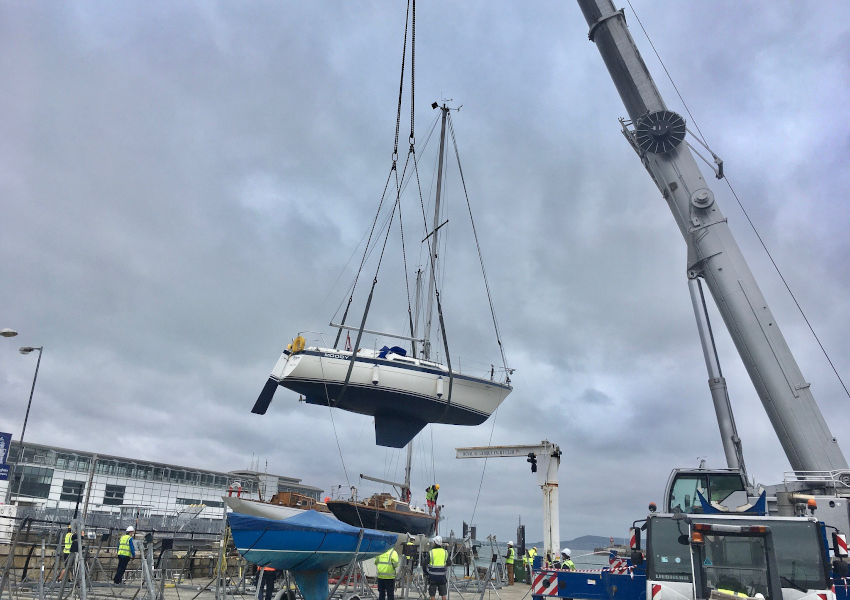
“Then by 2pm it was all over, done and dusted, a full three-and-a-half hours ahead of schedule. I have to say if this isn’t a roadmap as to how lift-ins should be conducted in future then we have all lost the plot.
“I cannot express the pride, satisfaction and gratitude I have for Darius, his boat house team and our team of helpers, Sarah and Elizabeth Fogarty, Toby and Herbie Fowler Hudson, Sean and Tadgh Donnelly, and Ciaran and Michael Hall sufficiently for the job they did today. Absolutely outstanding work.
“Dinghies can return from Friday next week onwards, so let the sailing season finally begin!”
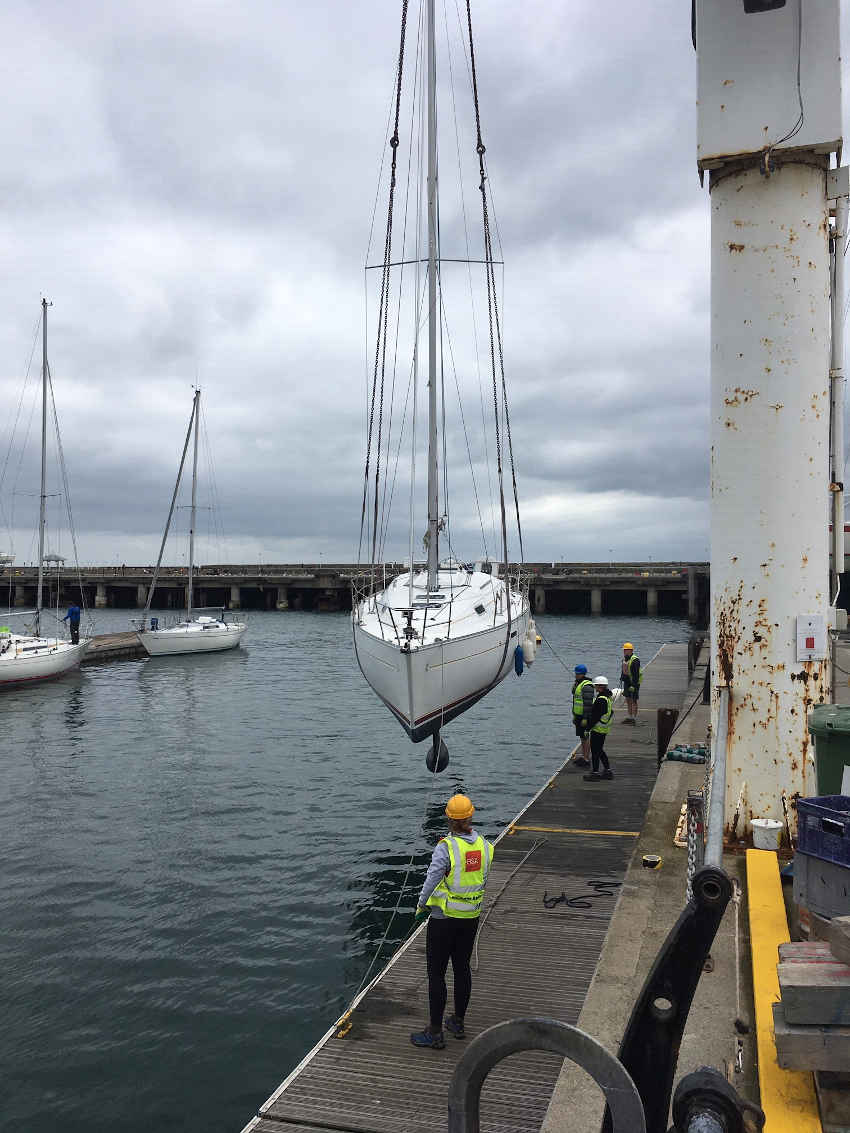
Bruce Lyster 1941-2020
The death of Bruce Lyster of Dun Laoghaire at the age of 78 is the sad loss to the Irish sailing community - and our maritime world generally - of a multi-talented figure who combined exceptional abilities in the financial and administrative areas with an abiding zest for the sea and sailing, and an engaging enthusiasm for encouraging others afloat through his work in sail training.
He showed such a talent for mathematical and financial studies in his boyhood that he was recruited directly from school in Dublin into the rising ranks of the growing international accountancy firm which became Price Waterhouse Cooper, while in sailing he was to go on to fill many roles, the most high-profile being as Commodore of the Royal St George Yacht Club from 1995 to 1998.
He came to this and many other significant positions through the combination of his special administrative talents, and a personal devotion to sailing which mainly expressed itself through sailing cruisers and offshore racing. In the late 1970s, he was one of several owners in Dun Laoghaire who campaigned a Ron Holland-designed 30ft Club Shamrock in DBSC and ISORA racing, but in 1979 the experience of coming through the notorious Fastnet Race storm of that year in Patrick Jameson’s Swan 40 Finndabar broadened his outlook.
Far from being put off high profile competition by this experience, for the season of 1980, he decided to go at top-level racing with exceptional thoroughness through the acquisition of the somewhat wayward but exceptionally fast Bruce Farr-designed New Zealand-built Half Tonner Swuzzlebubble, which Bruce Lyster rightly envisaged as being ideal for one season of flat-out campaigning
He recruited a crew of already proven but still rising talents of the calibre of Robert Dix, Drewry Pearson, Des Cummins and others to fulfil a dream season – run with typical Lyster efficiency on the basis of his quiet yet indomitable determination and special administrative talents – which by the end of the summer of 1980 saw Swuzzlebubble resplendent with many DBSC trophies, together with a host of prizes from a Cowes Week campaign in which they won every race except one, and at the end of August an overall win in the Abersoch-Howth Race which clinched the ISORA Championship Title for 1980.
He was out of the Irish scene for a while with a period working in New York, and when he returned it was to race and cruise in due course in the deeper comfort of the Sigma 38 class which developed in Dublin Bay around 1990, his own boat being Errislannan, named for that lovely bit of coastal west Connemara immediately south of Clifden, where the Lyster family had a holiday property.
However, it was in Dublin and Dublin Bay that he was now filling administrative roles in several organisations, for in addition to his rise through the officer ranks of the Royal St George YC, he was much involved with the Sail Training organisation, and played a key position in running the 1998 Tall Ships visit to Dublin, the largest gathering of tall Ships ever seen on the island.
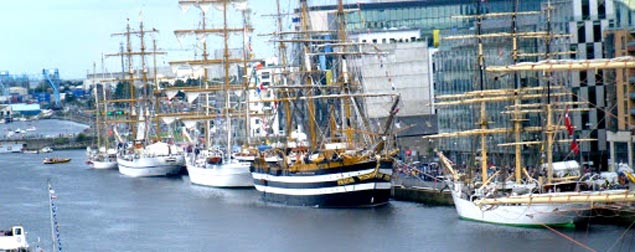 Tall Ships gather in Dublin Port. Bruce Lyster was in a key organising committee role during their record-breaking visit to Dublin in 1998
Tall Ships gather in Dublin Port. Bruce Lyster was in a key organising committee role during their record-breaking visit to Dublin in 1998
The fact that he was very active in this while in his final year as RStGYC Commodore gives some indication of Bruce Lyster’s ability for multi-tasking. But his renowned capacity for efficient administrative procedures and his legendary ability for the rapid analysis of a set of financial figures meant that – as one former colleague put it – “ten minutes of concentrated input from Bruce Lyster was worth an hour of anyone else’s more generalized opinions”
Inevitably this meant that in areas involving his most highly-developed levels of expertise, there would be times when he didn’t suffer fools gladly. But in everyday matters and in the general business of running organisations which supported his enthusiasm for the sea and sailing, he was the essence of charm with a quiet sense of special and alert humour which was much enjoyed by those privileged enough to experience it.
Sail Training remained one of his particular enthusiasms, and after retirement from professional life, he continued his involvement with Sail Training Ireland, something to which he gave a more tangible form through part-ownership - after the Errislannan years - of a Hallberg Rassy 38 in which he encouraged young crews to broaden their cruising and offshore experience.
At a different level, he served for many years as a Commissioner of Irish Lights while – unbeknown to his sailing world – he continued to be a valued adviser and committee member of the Irish Wheelchair Association.
As he scaled down his boat sizes with advancing age, he sailed for a while with the First 31.7 Camira, and his final sailing partnership was in the Shipman 28 Poppy.
His enjoyment in the company of fellow sailing enthusiasts never diminished, and those who knew Bruce Lyster will cherish his memory and the remarkable contribution he made to Ireland’s maritime life across a broad spectrum of interests, to each of which he gave dedicated commitment. Our heartfelt condolences are with his family and friends in this very sad loss.
WMN
Paddy Kirwan 1929-2017
Officially he was Captain Patrick Kirwan, a retired Senior Pilot with Aer Lingus. But for his many friends and shipmates in sailing at home and abroad, he was always Paddy Kirwan, whose death at the age of 88 has taken from us an energetic devotee of our sport, and one who contributed greatly to its development, while at the same time being lively company afloat and ashore.
Central to his contribution to sailing was his tenure as President of what was then the Irish Yachting Association from 1977 to 1982. When he succeeded Johnny Walker in Irish sailing’s premier role, he stated that his policy was under-pinned by the need to consolidate and expand.
From some administrators, this might have sounded like an intention so broad in its interpretation as to lack focus. But in the case of Paddy Kirwan it was very precise, based on his busy years as Chairman of the IYA’s Training & Junior Committee during the key growth years of the 1960s and 70s, when junior training became a central plank of the IYA platform.
Although he was from Cork, he spent most of his adult life in Dublin. In boyhood, he sailed, but aviation was his passion, and he acquired his Pilot’s Licence with the Air Corps, in which he served for several years. His increasing focus on life in Dublin was then finalised with a career change when became an Aer Lingus pilot in 1956 aged 27, and he stayed with the prestigious National Carrier for the rest of his working life, rising to the rank of Senior Captain.
He settled with his family in south Dublin, firstly at Mount Merrion and then at Blackrock. But with time and resources now available for a renewed interest in sailing, he was encouraged by fellow Aer Lingus sailors to join Howth, where many of them lived, and for a while he was much involved in the Howth sailing scene. He became a part-owner with Jim Higginbotham in the classic Howth Seventeen Mimosa in 1962, and they enjoyed a measure of racing success.
But he was soon also a member of the more conveniently located National Yacht Club in Dun Laoghaire, and with a growing family his interest in junior training came to the fore. He played a central role in the development of the Optimist dinghy class at the NYC, and though his achievements with the club’s junior committee run by Carmel Winkelmann saw him becoming the NYC Rear Commodore, the national authority had soon identified him to get involved on their behalf at a countrywide level, and he gave total commitment. His contribution to the development of the IYA was wide-ranging and effective, first in Junior Training, then also taking on the IYA Vice Presidency for Leinster, and finally in all areas on his election as President.
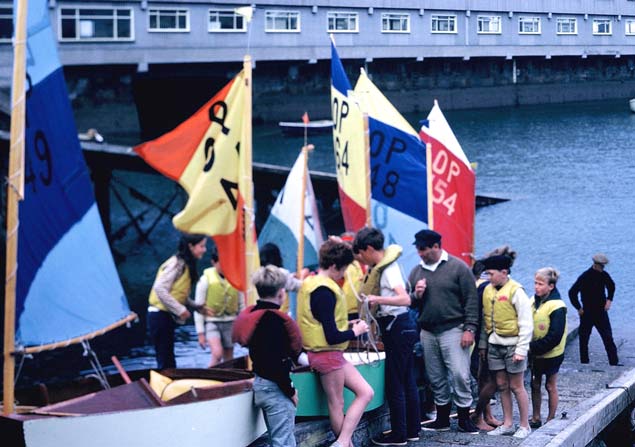 On hundred per cent involvement – junior trainer Paddy Kirwan in the midst of the new fleet of Optimists at the National Yacht Club in the 1960s, encouraging future sailors despite the primitive and crowded facilities of the time. Photo courtesy Ann Kirwan
On hundred per cent involvement – junior trainer Paddy Kirwan in the midst of the new fleet of Optimists at the National Yacht Club in the 1960s, encouraging future sailors despite the primitive and crowded facilities of the time. Photo courtesy Ann Kirwan
He had a sixth sense for discerning emerging sailing talent, and he persuaded a neighbour, Seamus Lyttle, that his son Mark and daughter Denise deserved every encouragement. He was right in both cases, and in 1981 a new height was reached when Denise became top girl in the Optimist Worlds, staged that year with an enormous global fleet at Howth, from which she went on to eventual Olympic participation.
Yet despite the time and energy Paddy Kirwan gave to junior training and the IYA, his own sailing career blossomed in Dun Laoghaire, and he was successful for several years in campaigning the Flying Fifteen Scooby Doo. With his navigational and tactical skills, he was also a useful crew-member in offshore racing, and was one of that elite band who have won an RORC race.
In his case, it was through the Howth links that he was invited to sail on Johnny Pearson’s International 8 Metre Cruiser/Racer Orana in the RORC Beaumaris-Cork Race of 1966. This was thought a decidedly sporting entry, as Orana had an unreasonably high RORC rating, and the opposition included some very serious heavy metal from the RORC heartlands in the Solent.
But the race took place over a weekend of total summer weather with calms at night. Yet while most of the fleet were becalmed far offshore while trying to get directly to the Tuskar Rock, with many kedged against the foul tide, Orana was right in along the beach in County Wexford, using the light but very real hay-scented night breeze off the land, dodging through sandy channels such as The Ram and The Sluice, and then at dawn carrying her breeze out to The Tuskar with a lead over the entire fleet of many miles, a line honours and overall corrected time lead she carried all the way to the finish at Cork Harbour.
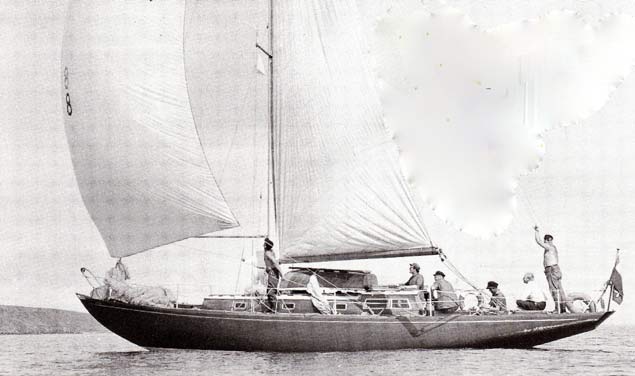 A famous victory. It is June 1966, and the 8 Metre Cruiser/Racer Orana is within yards of taking line honours and the overall win in the RORC Beaumaris-Cork Race. She carries a private breeze and the tide is with her, while most of the fleet are becalmed beyond the horizon. In savouring the moment, Orana’s crew have already put out their ensign, while crewmember Paddy Kirwan (standing at stern) is getting special enjoyment out of this very special return to his boyhood home of Cork.
A famous victory. It is June 1966, and the 8 Metre Cruiser/Racer Orana is within yards of taking line honours and the overall win in the RORC Beaumaris-Cork Race. She carries a private breeze and the tide is with her, while most of the fleet are becalmed beyond the horizon. In savouring the moment, Orana’s crew have already put out their ensign, while crewmember Paddy Kirwan (standing at stern) is getting special enjoyment out of this very special return to his boyhood home of Cork.
Subsequently he did a Fastnet Race on Orana, getting a class place, and then in due course, Paddy Kirwan had his own cruiser-racer, moving on in 1978 from the Flying Fifteen to the Ron Holland-designed Club Shamrock Boomerang. He campaigned inshore and offshore for many years, with his son Paul becoming increasingly involved, particularly after they’d moved in 1997 to the Sigma 38 Errislannan.
His enthusiasm for sailing and club life remained undimmed well into his eighties, and in his later years the Royal St George YC was added to his club list. But after he and Paul had changed from Errislannan to the new First 36.7 Boomerang in 2012, the illness which dominated his final two years began to assert itself, and his active role on board was inevitably diminished. Yet when he finally stepped ashore, it was after a long life around boats lived to the full, and many years of positive contribution to the development of our sport.
Our thoughts are with Paddy Kirwan’s children Paul, Ann, Garrett, Katy and Patrick, his wider family and grandchildren and great-grandchildren, and his many friends at this sad time.
WMN


























